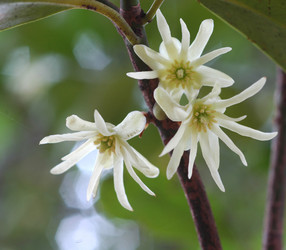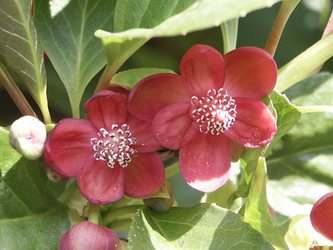Austrobaileyales



This tree diagram shows the relationships between several groups of organisms.
The root of the current tree connects the organisms featured in this tree to their containing group and the rest of the Tree of Life. The basal branching point in the tree represents the ancestor of the other groups in the tree. This ancestor diversified over time into several descendent subgroups, which are represented as internal nodes and terminal taxa to the right.

You can click on the root to travel down the Tree of Life all the way to the root of all Life, and you can click on the names of descendent subgroups to travel up the Tree of Life all the way to individual species.
For more information on ToL tree formatting, please see Interpreting the Tree or Classification. To learn more about phylogenetic trees, please visit our Phylogenetic Biology pages.
close boxReferences
Barkman, T. J., G. Chenery, J. R. McNeal, J. Lyons-Weiler, W. J. Ellisens, G. Moore, A. D. Wolfe, and C. W. dePamphilis. 2000. Independent and combined analyses of sequences from all three genomic compartments converge on the root of flowering plant phylogeny. Proceedings of the National Academy of Sciences (USA) 97:13166-13171.
Doyle, J. A. and P. K. Endress. 2000. Morphological phylogenetic analysis of basal angiosperms: Comparison and combination with molecular data. International Journal of Plant Sciences 161:S121-S153.
Endress, P. K. 2001. The flowers in extant basal angiosperms and inferences on ancestral flowers. International Journal of Plant Sciences 162:1111-1140.
Endress, P. K. and R. Honegger. 1980. The pollen of the Austrobaileyaceae and its phylogenetic significance. Grana 19:177-182.
Friedman, W. E., W. N. Gallup, and J. H. Williams. 2003. Female Gametophyte development in Kadsura: Implications for Schisandraceae, Austrobaileyales, and the early evolution of flowering plants. International Journal of Plant Sciences 164(5 Suppl.):S293-S305.
Hao G., M. L. Chey , and R. M. K. Saunders. 2001. A phylogenetic analysis of the Schisandraceae based on morphology and nuclear ribosomal ITS. Botanical Journal of the Linnean Society 135: 401-411.
Hao, G., R. M. K. Saunders, and M.-L. Chye. 2000. A phylogenetic analysis of the Illiciaceae based on sequences of internal transcribed spacers (ITS) of nuclear ribosomal DNA. Plant Systematics and Evolution 223:81-90.
Igersheim, A. and P. K. Endress. 1997. Gynoecium diversity and systematics of the Magnoliales and winteroids. Botanical Journal of the Linnean Society 124:213-271.
Judd, W. S., C. S. Campbell, E. A. Kellogg, P. F. Stevens, and M. J. Donoghue. 2002. Plant Systematics: A Phylogenetic Approach. Second Edition. Sinauer Associates, Inc., Sunderland, MA.
Qiu, Y. L., J. H. Lee, F. Bernasconi-Quadroni, D. E. Soltis, P. S. Soltis, M. Zanis, E. A. Zimmer, Z. D. Chen, V. Savolainen, and M. W. Chase. 1999. The earliest angiosperms: evidence from mitochondrial, plastid and nuclear genomes. Nature 402:404-407.
Qiu, Y. L., J. H. Lee, F. Bernasconi-Quadroni, D. E. Soltis, P. S. Soltis, M. Zanis, E. A. Zimmer, Z. D. Chen, V. Savolainen, and M. W. Chase. 2000. Phylogeny of basal angiosperms: Analyses of five genes from three genomes. International Journal of Plant Sciences 161:S3-S27.
Saunders, R. M. K. 1995. Systematics of the genus Illicium L. (Illiciaceae) in Malesia. Botanical Journal of the Linnean Society 117:333-352.
Saunders, R. M. K. 1998. Monograph of Kadsura (Schisandraceae). Systematic Botany Monographs 54. Ann Arbor, Michigan: The American Society of Plant Taxonomists, 106 pp.
Saunders, R. M. K. 2000. Monograph of Schisandra (Schisandraceae). Systematic Botany Monographs 58. Ann Arbor, Michigan: The American Society of Plant Taxonomists. 146 pp.
Saunders, R. M. K. 2001. Schisandraceae. Species Plantarum: Flora of the World 4. Canberra: Australian Biological Resources Study, 62 pp.
Savolainen, V., M. W. Chase, S. B. Hoot, C. M. Morton, D. E. Soltis, C. Bayer, M. F. Fay, A. Y. De Bruijn, S. Sullivan, and Y. L. Qiu. 2000. Phylogenetics of flowering plants based on combined analysis of plastid atpB and rbcL gene sequences. Systematic Biology 49:306-362.
Smith, A. C. 1947. The families Illiciaceae and Schisandraceae. Sargentia 7:1-224.
Soltis, D. E., P. S. Soltis, M. W. Chase, M. E. Mort, D. C. Albach, M. Zanis, V. Savolainen, W. H. Hahn, S. B. Hoot, M. F. Fay, M. Axtell, S. M. Swensen, L. M. Prince, W. J. Kress, K. C. Nixon, and J. S. Farris. 2000. Angiosperm phylogeny inferred from 18S rDNA, rbcL, and atpB sequences. Botanical Journal of the Linnean Society 133:381-461.
Williams, J. H. and W. E. Friedman. 2004. The four-celled female gametophyte of Illicium (Illiciaceae; Austrobaileyales): implications for understanding the origin and early evolution of monocots, eumagnoliids,and eudicots. American Journal of Botany 91:332-351.
Yamada, T., R. Imaichi, N. Prakash, and M. Kato. 2003. Developmental morphology of ovules and seeds of Austrobaileyales. Australian Journal of Botany 51(5):555-564.
Yang, Z.-R. and Q. Lin. 2005. Comparative morphology of the leaf epidermis in Schisandra (Schisandraceae). Botanical Journal of the Linnean Society 148(1):39-56.
Title Illustrations

| Scientific Name | Illicium religiosum |
|---|---|
| Location | Tsukuba, Ibaraki, Japan |
| Specimen Condition | Live Specimen |
| Source | Skimmia |
| Source Collection | Flickr |
| Image Use |
 This media file is licensed under the Creative Commons Attribution-NonCommercial-NoDerivs License - Version 2.0. This media file is licensed under the Creative Commons Attribution-NonCommercial-NoDerivs License - Version 2.0.
|
| Copyright | © 2007 autan |
| Scientific Name | Schisandra rubriflora |
|---|---|
| Location | cultivated, Royal Botanic Gardens, Kew, UK |
| Specimen Condition | Live Specimen |
| Source | Schisandra rubriflora |
| Source Collection | Flickr |
| Image Use |
 This media file is licensed under the Creative Commons Attribution License - Version 2.0. This media file is licensed under the Creative Commons Attribution License - Version 2.0.
|
| Copyright | © 2003 Scott Zona |
About This Page
Page copyright © 2002
 Page: Tree of Life
Austrobaileyales.
The TEXT of this page is licensed under the
Creative Commons Attribution-NonCommercial License - Version 3.0. Note that images and other media
featured on this page are each governed by their own license, and they may or may not be available
for reuse. Click on an image or a media link to access the media data window, which provides the
relevant licensing information. For the general terms and conditions of ToL material reuse and
redistribution, please see the Tree of Life Copyright
Policies.
Page: Tree of Life
Austrobaileyales.
The TEXT of this page is licensed under the
Creative Commons Attribution-NonCommercial License - Version 3.0. Note that images and other media
featured on this page are each governed by their own license, and they may or may not be available
for reuse. Click on an image or a media link to access the media data window, which provides the
relevant licensing information. For the general terms and conditions of ToL material reuse and
redistribution, please see the Tree of Life Copyright
Policies.
Citing this page:
Tree of Life Web Project. 2002. Austrobaileyales. Version 01 January 2002 (temporary). http://tolweb.org/Austrobaileyales/20650/2002.01.01 in The Tree of Life Web Project, http://tolweb.org/









 Go to quick links
Go to quick search
Go to navigation for this section of the ToL site
Go to detailed links for the ToL site
Go to quick links
Go to quick search
Go to navigation for this section of the ToL site
Go to detailed links for the ToL site